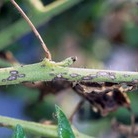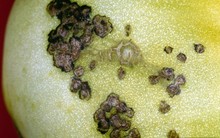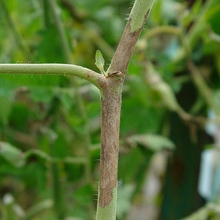Early blight
Caused by: Alternaria solaniProblem Category: Fungal Disease
Symptoms: Early blight symptoms start as oval shaped lesions with a yellow chlorotic region across the lesion; concentric leaf lesions may be seen on infected leaves; leaf tissue between veins is destroyed; severe infections can cause leaves to completely collapse; as the disease progresses leaves become severely blighted leading to reduced yield; tomato stems may become infected with the fungus leading to Alternaria stem canker; initial symptoms of of stem canker are the development of dark brown regions on the stem; stem cankers may enlarge to girdle the whole stem resulting in the death of the whole plant; brown streaks can be found in the vascular tissue above and below the canker region; fruit symptoms include small black v-shaped lesions at the shoulders of the fruit (the disease is also known black shoulder); lesions may also appear on the fruit as dark flecks with concentric ring pattern; fruit lesions can seen in the field or may develop during fruit transit to the market; the lesions may have a velvety appearance caused by sporulation of the fungus
Comments: Disease can spread rapidly after plants have set fruit; movement of air-borne spores and contact with infested soil are causes for the spread of the disease
Management: Apply appropriate fungicide at first sign of disease; destroy any volunteer solanaceous plants (tomato, potato, nightshade etc); practice crop rotation
Control: mix Dust 5kg ash in 50 litres of water and spray the solution to control early blight






